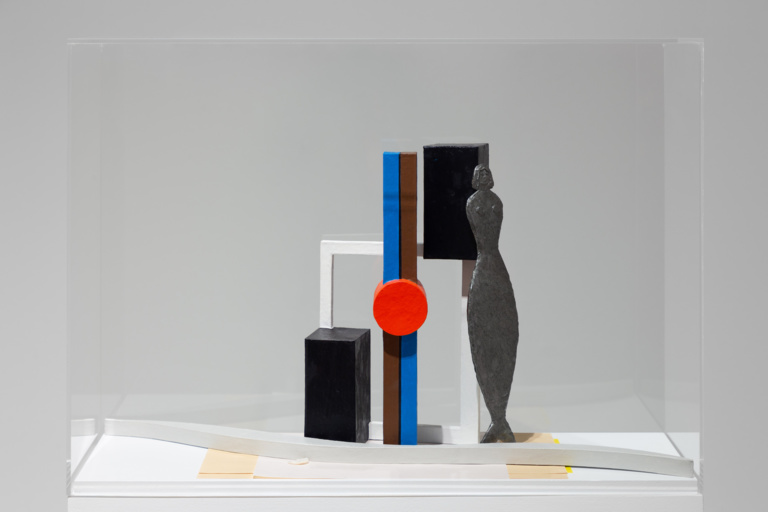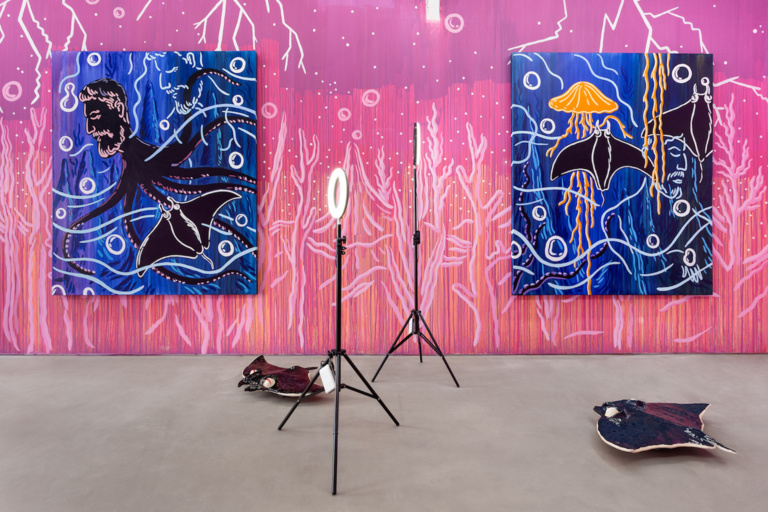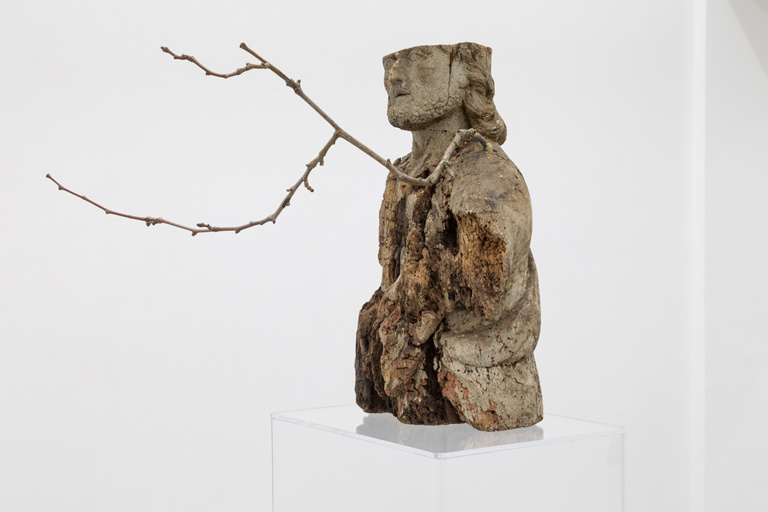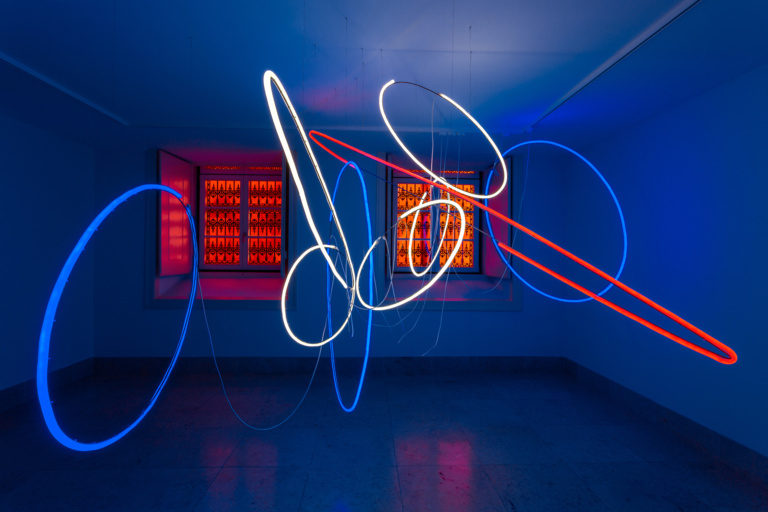Review — by Cristina Sanchez-Kozyreva
Spanning four rooms of Fundação Carmona e Costa, É só uma ferida (Just a wound), the solo exhibition by Pedro Barateiro, curated by João Mourão and Luís Silva, welcomes visitors with a large screen where an animated head pleasantly says “Olá!”. This black-and-white animation, Monologue for a Monster (2021), introduces the viewer to a nonchalant character who describe themselves as a monster, a cute creature, a receptacle, a poem, with mood swings and fluctuations, who loves to dance. The monster is a non-binary, eyeless head (with nose, mouth, and an abundance of long eyelashes) mounted on a pair of arms that function as legs. They don’t believe in good or evil, or on imposing their opinion on others, but they are clearly in need of self-expression, in a charming burst of existentialism.
Interview — by Adam Carr
I think I’m of the opinion that the world is way more interesting than things that happen in art galleries, and that people, when we’re in an art gallery, everything is charged where we pay massive attention to everything. Because it’s charged by the context of the white space and we know we should pay attention, we look for clues and signifiers and coded meaning, but we never walk through life with that kind of interest or intrigue in anything. If you look out the window now, the world is amazing. It’s full of signs and stories and urban narratives and traces, but we just don’t see them — we’re blind to them and I think we’re blind to them because there’s too many stimuli in the world. I
Review — by Cristina Sanchez-Kozyreva
Patente na Fidelidade Arte, a exposição Moon Foulard, do artista mexicano Rodrigo Hernández, que reside atualmente em Lisboa, apresenta-se como um diálogo etéreo em tons pastel entre o artista e o trabalho do designer de moda italiano Emilio Pucci — ou até como um gioco aperitivo em que Hernández, através da sua linguagem visual, interpreta o chique e extravagante mundo do "príncipe dos estampados". "A alegria foi um dos mais importantes elementos que trouxe para a moda. E trouxe-a através da cor" é uma das mais famosas citações de Pucci (1914–1992), uma carismática figura da cidade de Florença que vestia roupas justas e que, como se de fogo-de-artifício se tratassem, introduziu no mundo da moda malhas de seda psicadélicas feericamente coloridas, ora elásticas, ora folgadas, transformando assim o seu pequeno negócio de família num gigante da moda internacional.
Review — by Cristina Sanchez-Kozyreva
Em "Seabed Monsters and the Cosmic Rays", a terceira exposição de Luís Lázaro Matos na Madragoa, o artista propõe um entusiasmante universo imersivo que é simultaneamente cósmico e submarino. Sobre as paredes da pequena área expositiva sobem plantas aquáticas pintadas à mão em tonalidades rosa — uma coloração que recorda bactérias bioluminescentes e certas criaturas marinhas — que se confrontam com redes de relâmpagos brancos. A água e a eletricidade são uma mistura perigosa, mas aparentemente Matos inspirou-se na teoria de que, nos primórdios da génese da Terra, foram tempestades de relâmpagos que libertaram fósforo na água — um elemento essencial para a formação de biomoléculas e para o desenvolvimento de vida no planeta —, o que deu início ao processo da vida na Terra. Um bom sítio para começar.
Interview — by Sara De Chiara
Articulado sobretudo na escultura, instalação, vídeo e pósteres, o trabalho de Romão combina diferentes materiais, palavras, temporalidades e perspectivas que dão vida a um mundo em que o homem já não se encontra no centro. Um mundo de pernas para o ar em que o plástico transpira e as esculturas de madeira voltam a ser árvores. As dimensões do artefacto, do objecto manufacturado e produto da natureza coexistem aqui — não é claro onde uma termina e a outra começa —, evocando essa inclinação natural do pensamento no sentido do encantamento e do maravilhamento, aberto à metamorfose e pronto para captar a manifestação do sobrenatural em objectos do quotidiano. No final de contas, Naturália e Artificiália há muito que andam juntas sob o nome de Mirabília.
Interview — by Justin Jaeckle
A vegan falls ill after being tempted into trying lab-grown meat as an ethical source of protein. A spectral Lana Del Rey cover scores an abstracted narrative about a gay couple trying to get pregnant via biotech. A short story about four friends—a hetero and homosexual couple—expands that narrative into a relational drama dealing with broody 30-somethings and cis-male ovarian implants, against a backdrop of medical innovation and increasing male infertility, before reaching a Bartelby-esque conclusion. Thirteen shots of the same hand-held smartphone present us with 13 different on-screen poems. Whilst in the corner nanobots from the future kill off Sigmund Freud before he’s had a chance to develop his psychoanalytical framework.
Review — by José Marmeleira
What an invariably rewarding thing it is to follow an artist's career and observe its different stages. A particular trait may seem to recur at times, establishing a sort of thematic or formal constancy; then, a change of direction might take place as a new course is outlined. Indeed, aren't all artistic biographies made of such changes? Indissociable from such an exercise, acting as its opposite, another of a no less stimulating nature emerges: that of discovering or identifying a sensibility or a certain making which, though intangible, might interconnect all those moments: a longitudinal, subterranean background.







